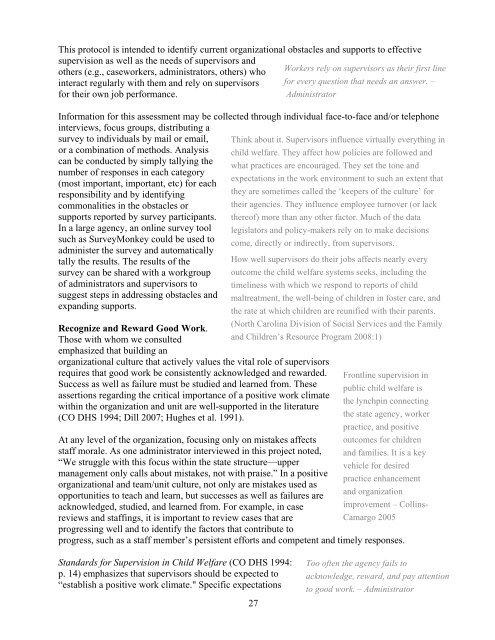Building a Model and Framework for Child Welfare Supervision
Building a Model and Framework for Child Welfare Supervision
Building a Model and Framework for Child Welfare Supervision
- No tags were found...
You also want an ePaper? Increase the reach of your titles
YUMPU automatically turns print PDFs into web optimized ePapers that Google loves.
This protocol is intended to identify current organizational obstacles <strong>and</strong> supports to effectivesupervision as well as the needs of supervisors <strong>and</strong>others (e.g., caseworkers, administrators, others) who Workers rely on supervisors as their first lineinteract regularly with them <strong>and</strong> rely on supervisors <strong>for</strong> every question that needs an answer. –<strong>for</strong> their own job per<strong>for</strong>mance.AdministratorIn<strong>for</strong>mation <strong>for</strong> this assessment may be collected through individual face-to-face <strong>and</strong>/or telephoneinterviews, focus groups, distributing asurvey to individuals by mail or email, Think about it. Supervisors influence virtually everything inor a combination of methods. Analysis child welfare. They affect how policies are followed <strong>and</strong>can be conducted by simply tallying thewhat practices are encouraged. They set the tone <strong>and</strong>number of responses in each categoryexpectations in the work environment to such an extent that(most important, important, etc) <strong>for</strong> eachresponsibility <strong>and</strong> by identifyingthey are sometimes called the ‘keepers of the culture’ <strong>for</strong>commonalities in the obstacles or their agencies. They influence employee turnover (or lacksupports reported by survey participants. thereof) more than any other factor. Much of the dataIn a large agency, an online survey tool legislators <strong>and</strong> policy-makers rely on to make decisionssuch as SurveyMonkey could be used to come, directly or indirectly, from supervisors.administer the survey <strong>and</strong> automaticallytally the results. The results of the How well supervisors do their jobs affects nearly everysurvey can be shared with a workgroup outcome the child welfare systems seeks, including theof administrators <strong>and</strong> supervisors to timeliness with which we respond to reports of childsuggest steps in addressing obstacles <strong>and</strong> maltreatment, the well-being of children in foster care, <strong>and</strong>exp<strong>and</strong>ing supports.the rate at which children are reunified with their parents.(North Carolina Division of Social Services <strong>and</strong> the FamilyRecognize <strong>and</strong> Reward Good Work.Those with whom we consulted<strong>and</strong> <strong>Child</strong>ren’s Resource Program 2008:1)emphasized that building anorganizational culture that actively values the vital role of supervisorsrequires that good work be consistently acknowledged <strong>and</strong> rewarded. Frontline supervision inSuccess as well as failure must be studied <strong>and</strong> learned from. These public child welfare isassertions regarding the critical importance of a positive work climatethe lynchpin connectingwithin the organization <strong>and</strong> unit are well-supported in the literature(CO DHS 1994; Dill 2007; Hughes et al. 1991).the state agency, workerpractice, <strong>and</strong> positiveAt any level of the organization, focusing only on mistakes affects outcomes <strong>for</strong> childrenstaff morale. As one administrator interviewed in this project noted, <strong>and</strong> families. It is a key“We struggle with this focus within the state structure—upper vehicle <strong>for</strong> desiredmanagement only calls about mistakes, not with praise.” In a positivepractice enhancementorganizational <strong>and</strong> team/unit culture, not only are mistakes used asopportunities to teach <strong>and</strong> learn, but successes as well as failures are<strong>and</strong> organizationacknowledged, studied, <strong>and</strong> learned from. For example, in case improvement – Collinsreviews<strong>and</strong> staffings, it is important to review cases that areCamargo 2005progressing well <strong>and</strong> to identify the factors that contribute toprogress, such as a staff member’s persistent ef<strong>for</strong>ts <strong>and</strong> competent <strong>and</strong> timely responses.St<strong>and</strong>ards <strong>for</strong> <strong>Supervision</strong> in <strong>Child</strong> <strong>Welfare</strong> (CO DHS 1994:p. 14) emphasizes that supervisors should be expected to“establish a positive work climate." Specific expectations27Too often the agency fails toacknowledge, reward, <strong>and</strong> pay attentionto good work. – Administrator
















